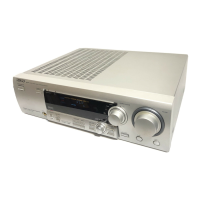
Do you have a question about the Philips FR-968 and is the answer not in the manual?
| Tuning range | FM, MW |
|---|---|
| Signal to noise ratio | 90dB (line) |
| Speaker load impedance | 8Ω to 16Ω |
| Video Connections | composite |
| Input Impedance | 47k ohms |
Registering product for maximum protection under warranty terms.
Registration card serves as proof of ownership in case of theft or loss.
Receive model-specific information and special offers.
Explanation of important safety symbols used in the manual.
Critical instructions for safe operation, installation, and maintenance.
Lists all items included with the receiver package.
Instructions for proper receiver placement and ventilation.
Details on packaging materials and recycling recommendations.
Mentions licensed trademarks such as Dolby Laboratories.
Guide to using the remote control for basic receiver functions.
Methods for setting up the remote for various appliance brands.
Procedure to restore the remote to its original Philips codes.
How to connect analog audio sources like VCR, CD player.
How to connect digital audio sources like CD recorder, DVD player.
Connecting receiver with Philips TV/VCR for system control.
Connecting video sources, including S-video for better quality.
Connecting the power cord and checking local voltage.
How to connect front, center, and surround speakers correctly.
Connecting AM and FM antennas for radio reception.
Advice on placing speakers for optimal sound experience.
Adjusting speaker settings like size, presence, and distance.
Adjusting speaker volumes for optimal surround sound playback.
Precautions regarding high power usage and potential overheating.
Connecting headphones and its effect on speaker output.
Cleaning and care instructions for the receiver unit.
Recommendations for subwoofer placement and general setup.
How to connect the subwoofer audio input to the receiver.
Procedures for turning the subwoofer on and putting it in standby.
Adjusting subwoofer volume and phase for optimal sound.
How the display shows connected speakers and signal status.
Symbols indicating menu status and navigation directions.
Explains the meaning of various indicator lights on the receiver.
How the display provides feedback on receiver status and messages.
Assigning audio inputs to different source selectors.
Settings for radio station storage and management.
Using the TV to set up the system via CINEMA LINK.
Using the selector knob to choose audio/video inputs.
Customizing source selections to different input connectors.
Connecting and using multichannel audio sources.
Steps to select and start playback from various sources.
How to adjust volume, bass, treble, and sound modes.
Procedures for recording audio/video from connected devices.
Introduction to surround sound and Dolby/DTS formats.
How to activate and cycle through different surround sound modes.
Descriptions of HALL, SURROUND, STEREO, and Virtual Surround modes.
Details on 3D SURROUND, MULTI FRONT/REAR, and NIGHT MODE.
Methods for finding AM/FM stations by scanning or frequency.
Automatic and manual programming of preset radio stations.
Selecting previously stored radio stations using presets.
Reordering presets and assigning custom names to radio stations.
Power consumption, dimensions, weight, and general specs.
FM/AM wave range, sensitivity, and distortion levels.
Impedance, drivers, dimensions, and weight of supplied speakers.
Details on what the warranty covers and what is not included.
Procedures for getting service in the USA and Canada.
Where service is available and essential record-keeping advice.